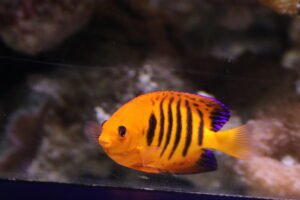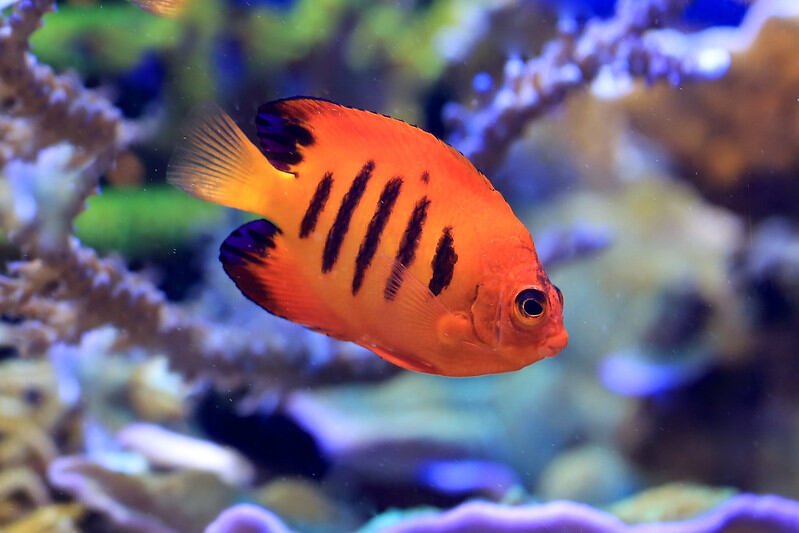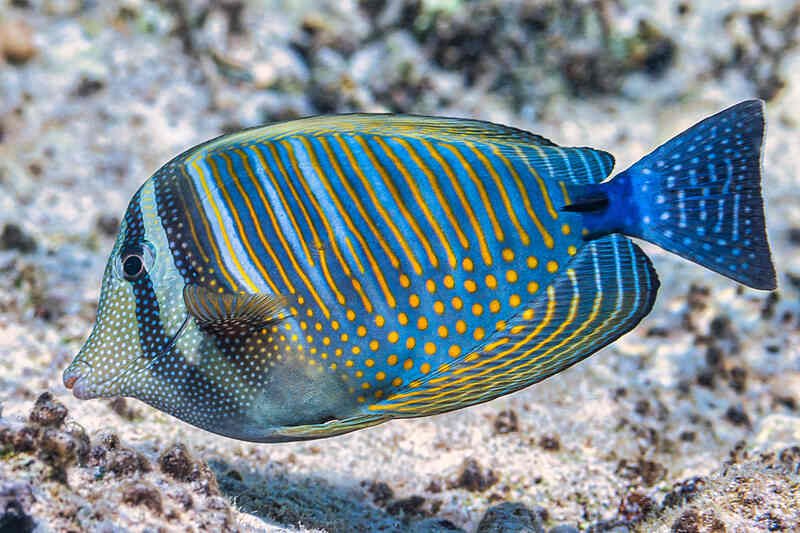Flame Angelfish (Centropyge loricula) are among the most striking and vibrant saltwater fish you can add to your aquarium. With their fiery red-orange bodies, accented by deep blue and black stripes, they’re sure to be the centerpiece of any tank.
However, like all saltwater fish, they require specific care to thrive. This guide will walk you through the essential steps to successfully keeping Angelfish in your saltwater aquarium.

Understanding the Flame Angelfish
Before diving into tank setup, it’s important to understand the nature and needs of Angelfish. These fish are native to the tropical waters of the Pacific Ocean, particularly around coral reefs. They’re small, reaching a maximum size of about 4 inches, but they are active swimmers with a semi-aggressive temperament. Flame Angelfish are generally hardy, making them suitable for intermediate aquarists, though beginners can also succeed with the right preparation.
Choosing the Right Tank Size
The first step in keeping an Angelfish is selecting an appropriately sized tank. Despite their small size, these fish are active and need plenty of space to swim. A minimum tank size of 30 gallons is recommended for a single Angelfish. However, if you plan to keep other fish or corals, a larger tank of 55 gallons or more is ideal. A larger tank will provide a more stable environment and reduce the likelihood of territorial aggression.
Water Parameters and Quality
Angelfish thrives in stable, high-quality water conditions. The key parameters to monitor are:
- Temperature: 72-78°F (22-26°C)
- pH: 8.1-8.4
- Salinity: 1.020-1.025 specific gravity
- Ammonia, Nitrite, Nitrate: Maintain 0 ppm of ammonia and nitrite. The ideal nitrate level is less than 20 ppm.
It is essential to do routine water changes to keep these conditions intact. A 10-20% water change every two weeks is recommended, depending on the load of your tank. Use a high-quality marine salt mix and ensure that the replacement water is properly mixed and aerated before adding it to the tank.

Setting Up the Tank Environment
Angelfish are naturally found in reef environments, so replicating this in your aquarium will make them feel at home. Start with a base of live rock, which not only provides hiding spots but also aids in biological filtration. In a gallon of water, use one to two pounds of live rock.
Adding live sand is also beneficial as it contributes to the natural filtration and gives your tank a more authentic look. When arranging the rockwork, create plenty of caves and crevices for your Angelfish to explore and hide. This is especially important if you have other fish in the tank, as it helps reduce stress and aggression.
Feeding Your Flame Angelfish
Angelfish are omnivores, and their diet in the wild consists of algae, small invertebrates, and detritus. To guarantee that animals in captivity get all the nutrients they need, a diversified diet is crucial.
Feed your Angelfish a mix of high-quality marine flakes or pellets, along with frozen foods like brine shrimp, mysis shrimp, and chopped seafood. Supplement their diet with algae-based foods, such as nori or spirulina, to replicate their natural grazing behavior. Make sure all food is eaten in a matter of minutes by giving tiny portions two to three times a day.
Compatibility with Other Fish
Angelfish can be semi-aggressive, especially towards other small or similarly colored fish. When choosing tank mates, it’s best to avoid other dwarf angelfish or species that closely resemble them in size and color. Ideal tank mates include larger, peaceful fish like tangs, wrasses, and gobies.
If you’re planning a reef tank, be aware that Flame Angelfish have a reputation for nipping at corals, particularly soft corals and polyps. While some individuals may not bother corals, others might develop a taste for them, so monitoring their behavior is crucial.

Introducing Angelfish to the Tank
Introducing a new fish to your tank should always be done with care to minimize stress. Start by quarantining your Angelfish in a separate tank for at least two weeks. This helps prevent the introduction of diseases to your main tank and allows you to observe the fish’s health and eating habits.
When ready to introduce the Angelfish to your display tank, do so with the lights off or dimmed. This reduces stress and aggression from other fish. Monitor the tank closely for the first few hours to ensure the Angelfish is acclimating well and not being harassed by other inhabitants.
Maintaining a Healthy Tank
Keeping an Angelfish healthy requires consistent tank maintenance. Regularly check your water parameters and perform routine water changes. Also, keep an eye on your fish for any signs of stress or illness, such as changes in color, behavior, or appetite. Identification of issues early on aids in preventing later, more significant issues.
Breeding Flame Angelfish
Breeding Flame in captivity is challenging and rarely achieved by hobbyists. They are pelagic spawners, meaning they release their eggs into the water column, where they are fertilized. The larvae are then carried by the current until they settle. Successfully breeding Flame requires very specific conditions, including a large, mature tank and a pair that has formed a strong bond.
If breeding is a goal, consider consulting with an expert or researching advanced techniques specific to marine angelfish breeding.
Common Challenges and Solutions
- Aggression: Flame can be territorial. Ensure your tank is large enough and has plenty of hiding spots to reduce aggression.
- Coral Nipping: If you notice your Flame nipping at corals, consider relocating the corals or providing more algae-based foods to reduce the behavior.
- Health Issues: Like all fish, Angelfish are susceptible to diseases like marine ich. Maintaining pristine water quality and a varied diet will help keep your fish healthy.
Flame Angelfish: A Vibrant Jewel of the Saltwater Aquarium
The Angelfish (Centropyge loricula) is one of the most sought-after species in the saltwater aquarium and freshwater aquarium hobby, renowned for its striking colors and dynamic presence. Native to the tropical waters of the Indo-Pacific, particularly around the reefs of the Hawaiian Islands, these fish captivate aquarists with their fiery hues and distinctive patterns.
Despite their beauty, keeping Angelfish can present unique challenges, making them both a prize and a test for dedicated aquarium enthusiasts.

The Natural Habitat of Flame Angelfish
In the wild, Angelfish inhabit coral-rich areas of lagoons and outer reef slopes. They are most commonly found at depths ranging from 15 to 60 feet, where they swim among the crevices of coral formations. This environment provides them with ample hiding spots and a varied diet, consisting mainly of algae and small invertebrates. The vibrant coral backdrop enhances the fish’s natural beauty, making them appear even more brilliant.
The environment they hail from plays a significant role in their well-being when kept in captivity. Replicating their natural habitat as closely as possible is crucial for their health and longevity. A well-established reef tank with plenty of live rock, hiding places, and stable water chemistry is ideal for keeping Flame Angelfish happy and healthy.
The Flame Angelfish’s Appearance
The Flame is named for its dazzling appearance, which seems to glow like a live ember. Its body is bright orange-red, with vertical black bars running along the sides. The fins are edged with iridescent blue, adding a contrasting highlight that enhances the fish’s fiery color. This color pattern varies slightly depending on the region of origin, with specimens from different areas displaying subtle differences in intensity and marking.
For example, Hawaiian Flame tends to have a more intense red coloration with fewer black bars, while those from the Marshall Islands might display a deeper orange hue. These regional variations add to the allure of collecting and keeping these fish, as some aquarists seek out specific local varieties to match their preferences or complete their collections.
Behavior and Compatibility in the Aquarium
Angelfish are generally considered semi-aggressive, a trait that is important to consider when introducing them into a community tank. They can be territorial, especially in smaller tanks or when first introduced. It’s common for them to assert dominance over similarly sized or shaped fish. However, in larger tanks with ample hiding spots and well-established territory, they usually settle down and coexist peacefully with other species.
Flame are often kept with other peaceful reef inhabitants, such as clownfish, gobies, and blennies. However, caution should be exercised when housing them with other dwarf angelfish, as territorial disputes can arise. Introducing them last to an established community or ensuring they have plenty of space can help mitigate potential aggression.
Feeding Flame Angelfish
In their natural habitat, Flame graze on algae and small invertebrates throughout the day. In an aquarium setting, they require a varied diet to thrive. High-quality marine angelfish preparations, which include algae and spirulina, should be a staple in their diet. Additionally, they benefit from the inclusion of frozen or live foods such as brine shrimp, mysis shrimp, and finely chopped seafood.
A well-fed Flame is more likely to exhibit its full coloration and remain healthy. Ensuring that they receive multiple small feedings throughout the day can replicate their natural grazing behavior and keep them active and content.
Acclimation and Care Considerations
Introducing a Flame to a new aquarium requires careful acclimation, as they can be sensitive to changes in water parameters. The drip acclimation method is often recommended, as it allows the fish to gradually adjust to the new water conditions. This process can help reduce stress and improve the chances of a successful introduction.
Once acclimated, maintaining pristine water quality is essential. Regular water changes, stable salinity, and monitoring for nitrates and phosphates are crucial for their long-term health. A well-maintained aquarium not only supports their physical health but also encourages their natural behavior and vibrant coloration.

Flame Angelfish and Reef Tanks
One of the most debated topics among saltwater aquarists is whether Angelfish is truly reef-safe. While they are generally considered “reef-friendly,” their behavior can vary from individual to individual. Some Angelfish may nip at coral polyps or clam mantles, especially if they are underfed or stressed. This can be problematic in a tank with delicate or prized corals.
To minimize the risk of coral nipping, it is essential to provide ample food and ensure that the fish is well-fed. Observing their behavior closely after introduction to a reef tank is also recommended. If an Angelfish does show a propensity for nipping, it may be necessary to remove it from the reef environment or accept some level of coral predation as part of the cost of keeping such a stunning fish.
Breeding Flame Angelfish
Breeding Angelfish in captivity is a challenging endeavor that few aquarists have successfully achieved. These fish are protogynous hermaphrodites, meaning they have the ability to change sex from female to male, a process that occurs naturally in the wild but is rarely observed in home aquariums.
In the wild, Angelfish form harems, with one dominant male and several females. This social structure can be difficult to replicate in captivity, as space limitations and the challenges of introducing multiple angelfish can lead to aggression. For those who are interested in attempting to breed Angelfish, providing a large tank with ample hiding spots and closely monitoring their interactions is key.
Successful breeding in captivity often requires specialized equipment, including larval-rearing tanks and a steady supply of live food for the fry. Even with the right conditions, breeding Angelfish remains a rare achievement, making captive-bred specimens highly prized in the hobby.
The Cost of Owning a Flame Angelfish
Flame Angelfish are not only prized for their beauty but also for their rarity and the difficulty of collecting them from the wild. Depending on their size, coloration, and region of origin, Angelfish can command a high price in the aquarium trade. Specimens from regions like Hawaii or the Cook Islands are often more expensive due to their intense coloration and the logistical challenges of sustainable collection.
In addition to the initial purchase price, the cost of maintaining a Angelfish should be considered. They require a well-maintained saltwater aquarium with high-quality filtration, live rock, and a varied diet. The investment in equipment and ongoing care is significant, but for many aquarists, the reward of owning such a striking and dynamic fish is well worth the effort.
Conservation and Ethical Considerations
As with many marine species, the collection of Angelfish from the wild raises important conservation and ethical considerations. Overfishing and habitat destruction threaten their natural populations, and the demand for these fish in the aquarium trade can contribute to these pressures. Sustainable collection practices and supporting captive breeding programs are crucial for the long-term survival of Angelfish in the wild.
Aquarists should consider purchasing captive-bred specimens when available, as these fish are often healthier, better adapted to aquarium life, and do not contribute to the depletion of wild populations. Supporting reputable suppliers who engage in sustainable and ethical practices is also essential for protecting these beautiful creatures and the ecosystems they inhabit.

The Joy of Keeping Flame Angelfish
For those who are up to the challenge, keeping a Angelfish can be an incredibly rewarding experience. Their vibrant colors, lively behavior, and the unique challenges they present make them a standout species in any saltwater aquarium. Whether kept in a reef tank or a fish-only setup, the Angelfish adds a touch of the tropics to the home and captivates anyone who sees it.
The key to successfully keeping Angelfish lies in understanding their needs and providing an environment that closely mimics their natural habitat. With proper care, these fiery gems can thrive in captivity, offering years of enjoyment and a living reminder of the beauty and diversity of the ocean.
Final Thoughts
Flame Angelfish are more than just a beautiful addition to a saltwater aquarium; they are a symbol of the delicate balance between enjoying the wonders of marine life and the responsibility of protecting it. Their vivid colors and spirited personalities make them a favorite among aquarists, while their care requires a deep commitment to maintaining a healthy and stable environment.
For those who succeed in keeping them, the Angelfish is a living testament to the beauty of the natural world and a reminder of the importance of conservation in the aquarium hobby.


